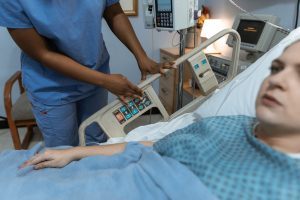4.2.2 General Guidelines for Assisting Clients with Body Movements
In this chapter, we will look at the different tasks involved in assisting clients with movement. Follow these general guidelines regarding any activity:
- Is the doctor’s order for the task on the care plan? If not, why?
- Wash your hands and don the PPE needed for the client and task.
- Provide privacy.
- Do you understand how to complete the task? If not, get help.
- Are you trained to complete this task correctly and safely? If not, get help.
- Determine what you will need for this task. Have supplies ready to be used at the point of care.
- Have you positively identified the client (i.e., check their photo badge or bracelet)?
- What type of clothing and footwear does the client need for this task/activity? Is their footwear slippery on the bottom? Does it have a rubber sole to reduce the potential of the client slipping and falling?
- Can the client see well? Do they need glasses on to see?
- If you are helping with mobility, what does the pathway from the starting point to the end destination look like? Is it cleared or is there clutter in the way? Are there rugs which may move?
- Have you advised the client/person you are assisting what is entailed with the task and the process? Using numbers for cueing will help clear up communication for tasks (on the count of 3, we will stand, etc.).
- Does the client/person agree with the task? If they are confused or do not wish to complete the task, get help or contact the supervisor to problem-solve in order to avoid injury with unplanned movements of the client during the process.
- Is the client able to assist with the task or do you need assistance? Assess their ability to move, stand, process information, and hear the instructions.
- Is the person who is assisting you aware of the client’s status and able to help? If not, only allow them to assist as they are able. If no-one else is available, assess your ability to complete the portion of the task which you are capable of completing, correctly, comfortably, and safely, as you know the client and advise the client you will need to have assistance for the remainder of the task.
- Do you need the assistance of a lift, mat, belt, turner or brace? Make sure the needed device and supplies are near the client and operating correctly; test the devices prior to use.
- Does the client have any tubes or medical apparatus attached to their body? Prior to starting, make a plan to keep them attached during the tasks required.
- Make certain after the task that the client is comfortable, knows how long they will be in that position and has a call button in easy reach.
We will now look at specific movements that you will commonly need to complete with your client. Remember to use the checklist above for all of these movements, in addition to the guidance provided later in this chapter.

Media Attributions
- pexels-rodnae-productions-6129208 © RODNAE Productions is licensed under a CC0 (Creative Commons Zero) license

